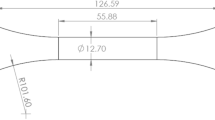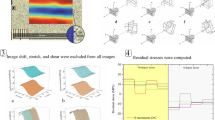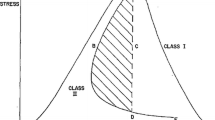Abstract
Background
For the mechanical testing of materials, the electromechanical or hydraulic testing facility should be periodically aligned. The ASTM standard E1012 prescribes some procedures for aligning the test facility, after which alignment is taken for granted during the subsequent mechanical testing of the actual specimen.
Objective
The goal of this paper is to develop methods based on stereo-Digital Image Correlation (stereo-DIC) to quantitatively measure the misalignment during static and fatigue testing.
Methods
Two methods, a measurement device and a novel linear decomposition approach were implemented in this study, both relying on stereo-DIC data. The measurement device can be mounted on two sides of the tested specimen and moves together with the corresponding specimen ends as a rigid body. The rigid translation and rotation can be extracted by rigid body transformation from the stereo-DIC measurement, without any numerical model linked to it. Linear decomposition is based on minimizing the discrepancy in displacement between simulation and experiment. By assuming linear elastic material behavior and small deformation, linear decomposition will result in a group of linear equations with variables quantifying misalignment in boundary conditions.
Results
Both the measurement device and linear decomposition have been successfully utilized in high-cycle fatigue testing. Although both the measurement device and linear decomposition gave close values in the three-dimensional concentric and angular misalignment, the numerical simulation with misaligned boundary conditions given by linear decomposition reproduced more accurate displacement fields on the gauge section of the specimen than the measurement device.
Conclusions
The reason why the measurement device has relatively lower precision than linear decomposition approach is due to the shallow depth of field around the measurement device in stereo-DIC. The measurement device can be applied in broad testing conditions following the same procedure while linear decomposition is limited to cases where linear superposition holds in identifying the misaligned boundary conditions, meaning that geometric and material nonlinearity are excluded.











Similar content being viewed by others
Data Availability
Data will be made available on request.
References
Robinson DC (1969) Misalinement Detector for Axial Loading Fatigue Machines, Engineering Mechanics Section, Mechanics Division, Institute for Basic Standards, National Bureau of Standards
ASTM International (2021) ASTM E606/E606M - 21 Standard Test Method for Strain-Controlled Fatigue Testing. American Society for Testing and Materials, West Conshohocken, PA
ASTM International (2021) ASTM E466-21 Standard Practice for Conducting Force Controlled Constant Amplitude Axial Fatigue Tests of Metallic Materials. American Society for Testing and Materials, West Conshohocken, PA
ASTM International (2022) ASTM E8/E8M − 22 Standard Test Methods for Tension Testing of Metallic Materials. American Society for Testing and Materials, West Conshohocken, PA
ASTM International (2018) ASTM E139-11 Standard Test Methods for Conducting Creep, Creep-Rupture, and Stress-Rupture Tests of Metallic Materials. American Society for Testing and Materials, West Conshohocken, PA
ASTM International (2019) ASTM E1012-19 Standard practice for verification of testing frame and specimen alignment under tensile and compressive axial force application. American Society for Testing and Materials, West Conshohocken, PA
Schreier H, Orteu J-J, Sutton MA (2009) Image correlation for shape, motion and deformation measurements. Springer US. https://doi.org/10.1007/978-0-387-78747-3
Pan B (2018) Digital image correlation for surface deformation measurement: historical developments, recent advances and future goals. Meas Sci Technol 29(8):082001. https://doi.org/10.1088/2F1361-6501%2Faac55b
Luo H, Yu L, Pan B (2021) Design and validation of a demand-oriented single-camera stereo-DIC system with a four-mirror adapter. Measurement 186:110083. https://doi.org/10.1016/2Fj.measurement.2021.110083
Rajan S, Sutton MA, Sockalingam S, McMakin W, Gurdal Z, Kidane A (2020) Simulations and experiments for automated fiber placement of prepreg slit tape: Wrinkle formation and fundamental observations. Compos Part B Eng 201:108287. https://doi.org/10.1016/2Fj.compositesb.2020.108287
Rajan S, Sutton MA, Wehbe R, Tatting B, Gurdal Z, Kidane A (2019) Measured Surface Deformation and Strains in Thin Thermoplastic Prepreg Tapes Steered along Curved Paths without Adhesion Using StereoDIC. Exp Mech 59(4):531–547. https://doi.org/10.1007/2Fs11340-019-00478-3
Rebergue G, Blaysat B, Chanal H, Duc E (2022) In-situ measurement of machining part deflection with Digital Image Correlation. Measurement 187:110301. https://doi.org/10.1016/2Fj.measurement.2021.110301
Hagara M, Trebuňa F, Pástor M, Huňady R, Lengvarský P (2019) Analysis of the aspects of residual stresses quantification performed by 3D DIC combined with standardized hole-drilling method. Measurement 137:238–256. https://doi.org/10.1016/2Fj.measurement.2019.01.028
Dvurecenska K, Diamantakos I, Hack E, Lampeas G, Patterson EA, Siebert T (2021) The validation of a full-field deformation analysis of an aircraft panel: A case study. J Strain Anal Eng 56(4):265–272. https://doi.org/10.1177/2F0309324720971140
Christian W, Dean A, Dvurecenska K, Middleton C, Patterson E4 (2021) Comparing full-field data from structural components with complicated geometries. R Soc Open Sci 8(9):210916. https://doi.org/10.1098/2Frsos.210916
Patterson EA, Diamantakos I, Dvurecenska K, Greene RJ, Hack E, Lampeas G et al (2022) Validation of a structural model of an aircraft cockpit panel: An industrial case study. J Strain Anal Eng 57(8):714–723. https://doi.org/10.1177/03093247211059084
Pierron F (2023) Material Testing 2.0: A brief review. Strain e12434. https://doi.org/10.1111/str.12434
Dizaji MS, Alipour M, Harris DK (2018) Leveraging Full-Field Measurement from 3D Digital Image Correlation for Structural Identification. Exp Mech 58(7):1049–1066. https://doi.org/10.1007/s11340-018-0401-8
Evans SL, Holt CA (2009) Measuring the mechanical properties of human skin in vivo using digital image correlation and finite element modelling. J Strain Anal Eng 44(5):337–345. https://doi.org/10.1243/03093247JSA488
Gerbig D, Bower A, Savic V, Hector LG (2016) Coupling digital image correlation and finite element analysis to determine constitutive parameters in necking tensile specimens. Int J Solids Struct 97–98:496–509. https://doi.org/10.1016/j.ijsolstr.2016.06.038
Leng X, Deng X, Ravindran S, Kidane A, Lessner S, Sutton M et al (2022) Viscoelastic Behavior of Porcine Arterial Tissue: Experimental and Numerical Study. Exp Mech 62(6):953–967. https://doi.org/10.1007/s11340-022-00852-8
Moerman KM, Holt CA, Evans SL, Simms CK (2009) Digital image correlation and finite element modelling as a method to determine mechanical properties of human soft tissue in vivo. J Biomech 42(8):1150–1153. https://doi.org/10.1016/j.jbiomech.2009.02.016
Shen B, Paulino G (2011) Direct extraction of cohesive fracture properties from digital image correlation: a hybrid inverse technique. Exp Mech 51(2):143–163. https://doi.org/10.1007/s11340-010-9342-6
Réthoré J (2010) A fully integrated noise robust strategy for the identification of constitutive laws from digital images. Int J Numer Meth Eng 84(6):631–660. https://doi.org/10.1002/nme.2908
Mathieu F, Leclerc H, Hild F, Roux S (2015) Estimation of elastoplastic parameters via weighted FEMU and integrated-DIC. Exp Mech 55(1):105–119. https://doi.org/10.1007/s11340-014-9888-9
Jailin T, Tardif N, Desquines J, Chaudet P, Coret M, Baietto M-C et al (2022) FEMU based identification of the creep behavior of Zircaloy-4 claddings under simulated RIA thermo-mechanical conditions. J Nucl Mater 561:153542. https://doi.org/10.1016/j.jnucmat.2022.153542
Lopez-Crespo P, Shterenlikht A, Patterson E, Yates J, Withers P (2008) The stress intensity of mixed mode cracks determined by digital image correlation. J Strain Anal Eng 43(8):769–780. https://doi.org/10.1243/03093247jsa419
Pottier T, Toussaint F, Vacher P (2011) Contribution of heterogeneous strain field measurements and boundary conditions modelling in inverse identification of material parameters. EUR J MECH A-SOLID 30(3):373–382. https://doi.org/10.1016/j.euromechsol.2010.10.001
Zaplatić A, Vrgoč A, Tomičević Z, Hild F (2023) Boundary condition effect on the evaluation of stress triaxiality fields. Int J Mech Sci 246:108127. https://doi.org/10.1016/j.ijmecsci.2023.108127
Fedele R (2015) Simultaneous assessment of mechanical properties and boundary conditions based on digital image correlation. Exp Mech 55(1):139–153. https://doi.org/10.1007/s11340-014-9931-x
Pierron F, Grédiac M (2021) Towards Material Testing 2.0. A review of test design for identification of constitutive parameters from full‐field measurements. Strain 57(1):e12370. https://doi.org/10.1111/str.12370
Han S, Dinh TD, De Baere I, Van Paepegem W (2022) Relation between ASTM E606 specimen geometry and misalignment in strain-controlled fatigue testing. Int J Fatigue 107282. https://doi.org/10.1016/j.ijfatigue.2022.107282
VIC-3D 9 (2022) Version 9.4.22. Correlated Solutions Inc. https://www.correlatedsolutions.com
Levoy M (2014) Finding optimal rotation and translation between corresponding 3D points. http://graphics.stanford.edu/courses/cs178/
Ho N (2021) Optics 1: lenses and apertures. http://nghiaho.com/?page_id=671
ABAQUS (2023) Dassault Systèmes Simulia Corp. www.3ds.com
MATLAB (2022) R2022a. The MathWorks, Inc. https://www.mathworks.com
Acknowledgements
This project has received funding from the European Union’s Horizon 2020 research and innovation programme under grant agreement No 862017. The authors would like to acknowledge the financial support of SIM (Strategic Initiative Materials in Flanders) and VLAIO (Flemish government agency, Flanders Innovation & Entrepreneurship) through the M3-FATAM project (HBC.2016.0446), part of the MacroModelMat (M3) research program, coordinated by Siemens (Siemens Digital Industries Software, Belgium). The authors would like to acknowledge Materialise NV for printing the measurement device ‘antenna’ and AM Ti-6Al-4V samples used in this study. The authors would like to express their gratitude to Josef Sommer for his support during the development of the data acquisition system.
Author information
Authors and Affiliations
Contributions
Shiwei Han: Methodology, Formal analysis, Data curation, Writing-original draft. Tien Dung Dinh: Writing-review & editing. Ives De Baere: Conceptualization, Supervision, Investigation, Writing – review & editing. Wim Van Paepegem: Conceptualization, Supervision, Investigation, Project administration, Funding acquisition, Writing – review & editing.
Corresponding author
Ethics declarations
Conflict of Interest
The authors declare that they have no known competing financial interests or personal relationships that could have appeared to influence the work reported in this paper.
Additional information
Publisher's Note
Springer Nature remains neutral with regard to jurisdictional claims in published maps and institutional affiliations.
Rights and permissions
Springer Nature or its licensor (e.g. a society or other partner) holds exclusive rights to this article under a publishing agreement with the author(s) or other rightsholder(s); author self-archiving of the accepted manuscript version of this article is solely governed by the terms of such publishing agreement and applicable law.
About this article
Cite this article
Han, S., Dinh, T.D., De Baere, I. et al. Measurement of Three-Dimensional Concentric and Angular Misalignment in Static and Fatigue Testing of Materials by Stereo-Digital Image Correlation. Exp Mech 63, 1239–1254 (2023). https://doi.org/10.1007/s11340-023-00984-5
Received:
Accepted:
Published:
Issue Date:
DOI: https://doi.org/10.1007/s11340-023-00984-5




